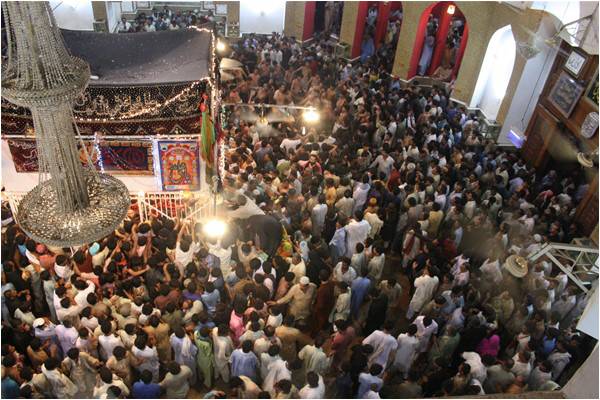
“Tulu-e-seher he sham-e-qalandar”
(The evening at Qalandar’s is the break of a dawn)
He is bound to have had before his eyes an ecstatic blur of bodies, fabrics, and hair. That evening in Sehwan, when the suicide bomber entered the shrine, followers were performing a daily ritual. As the powerful bomb went off, it would have sliced through a familiar orchestra, the sonic spiral of drums and reed, the cries and chants of mast qalandar. What must have immediately followed is impossible to describe, let alone put to page. What is, however, imaginable is this: as with most Thursdays, people were gathering in the shrine’s forecourt to perform dhamal, claiming every spot on its white marble floor; their bodies were facing the shrine’s tall wooden doors, as is custom; and inside, in the octagonal durbar, countless pilgrims were circling the tomb of Lal Shahbaz Qalandar (d. 1274). How painfully routine it must have all been to an ethnographer like myself who had witnessed this scene day after day, year after year. I can also say with measured certainty that in the countdown to the ritual, hereditary musicians would have found their usual spots around large kettledrums lined with copper, women healers and male photographers-on-hire would have kept an eye out for clients, chai wallahs would have been selling tea to pilgrims, and a handful of policemen whose faces I can clearly recall would have been on duty. Pushing their way through the rallying crowds, they must have secured the divide between single men and women; they would have struggled to maintain the flow of bodies through the length of the court. Nothing about this scene would have been surprising: the teeming crowds, the occasional brawl, not even the palpable anticipation in the air. With every strike on the metal disc ghant, men would have grown more restless to swing to their feet and women would have waited for cohabiting malevolent spirits to become present at the summons of the saint. Families would have sat beside them.
To portray an Islam of the shrines as simply tolerant, peace-loving and compassionate captures only the dynamism of what is easily observable at such places: shrine music, ritual dance, multi-faith pilgrims. All true. But historically deep-seated constellations of power, structures of orthodoxies, and contestations of authorities are much harder to observe
Then, with the first sound of drums, the crowd would have burst into loud chants and within seconds the entire courtyard would have turned visceral to the tune of the reed. Men would have sprung open their arms to the skies. Across, in the same courtyard, women would have moved in rigorous circularity. And as always, within minutes, their bright chadars would have fallen away, their long plaits becoming systematically undone to release spirits through the passage of hair. Incrementally but unfailingly, the atmosphere in the courtyard would have risen manifold. Yet the flow of devoted to the inner shrine would have remained unbroken even if temporarily clogged.
It was amid such scenes that one man with no vows for a son, no fragrant offerings in the long folds of his shirt would have found his way to the inner sanctum of the saint. He had not come to seek health; he had no desire to perform dhamal; he carried no sweets for the saint either. He came instead with another wish, anxious to let something ungodly loose in what would become a long night of terror.
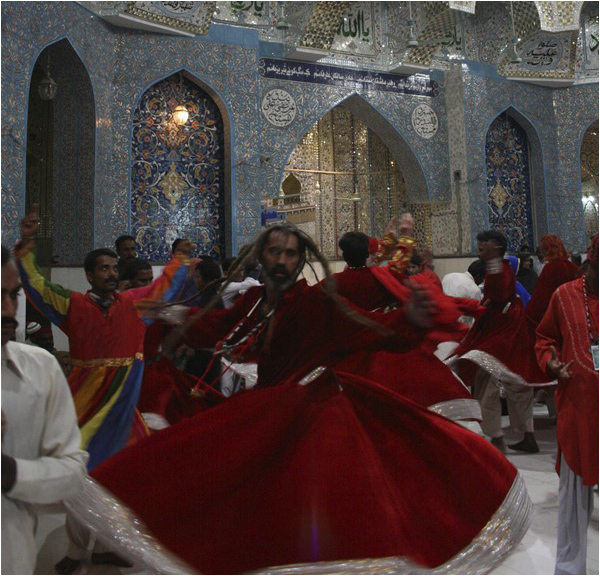
Shocking as these are, deadly attacks at shrines are no longer new in Pakistan. Some would say, it was but a matter of time. Sehwan, with its devotional prominence and millions of annual pilgrims, qualifies as an obvious target. Placing it as the latest entrant on a decade-long timeline of attacks on Pakistani shrines makes complete sense, even so in a tragic way. Radical Islamist groups have a declared hatred for saints’ shrines. But to strike at Sehwan is to strike at the core of everything plural about Pakistan. In a way it also confirms why the hostility towards shrines cannot simply be reduced to the Pakistani liberal mantra of a clash between music-loving Sufis and bomb-bearing Islamists. An attack at a shrine is one spectacular manifestation of the ever-diminishing space for dissent and difference in the republic. In other words, the easy idea that one kind of Islam is under threat from another kind of Islam is not only flawed, it is plain shoddy. In limiting the discussion to religion, we refuse to take measure of other forms of pluralism that are equally at risk in Pakistan today. In fact, an over-determined reliance on the paradigm of Islam is analytically futile precisely because it fails to grasp the full extent of what is at stake in Pakistan’s fraught relationship with places such as Sehwan—or to borrow Carla Bellamy’s take on Islamic shrines, with ambiguously sacred places. Here ambiguity, not Islam is the word to take home.
“Teht-o-saran ton arsh-e-ulan tak, sare da sara raqba Ali da!”
(From the depths of the earth to the highest of heavens, all is the territory of Ali)
I first arrived in Sehwan in the summer of 2009 for a four-week stay as part of my MA research. I was admissibly mesmerised by the haptic world I was newly confronted with. At the same time, I was struggling with distance. Hardly 300km away from home, I was among a people whose experience of the same religion as my own took such dramatic and emotionally powerful forms. Fascination was one response. Until then, I had had no sustained contact with sufis or their shrines. Ziy?rat to a dargah never featured in our daily lives. Much before the deadly targeting of shrines had begun, reformist and liberal critiques of shrine practices had already been buoyant in the 1980s and 1990s on television screens, in Friday sermons, in printed literature and on public forums, in reformist tablighi movements and through women-only religious meetings in the domestic sphere. Add to this the fact that I was raised in an Ahl-e-hadis family with a recently disowned Hanafi history. Over the course of my life I had witnessed a niyaz-offering, milad-hosting and chehlum-observing family being made to view its own religious practices as suspect and in need of purification of its Indic heritage. Ambiguity in matters of faith was just plain risqué.
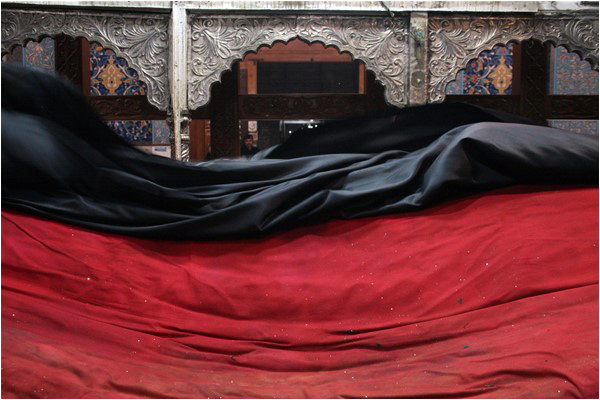
Qalandar stands at the cusp of so many conceptions of the divine and the charismatic. He is known to belong to an original band of thirteenth-century qalandars or antinomian mystics characterised by their perpetual wandering, their rejection of religious and social norms and extreme forms of asceticism
At the end of four weeks, I remember having returned with a lot more questions than answers. I was trying to make sense of a cosmopolitanism I had just encountered in a small pilgrimage town. I struggled to find my own two feet not just as a researcher but also in a broader cultural sense. The most astonishing of realisations was a small one. All along Qalandar had been an un-deciphered figure I had grown up with. Even today, I marvel at how ubiquitous the reference to Qalandar is in everyday Pakistan. Not a day goes by without coming across his name in songs or behind trucks and rickshaws, on begging bowls at traffic lights, on urban graffiti and car stickers. It is not surprising that my earliest memory of the word qalandar goes back to a Punjabi dhamal mostly sung at weddings by the women of the family. We weren’t Punjabi-speaking and my childhood understanding of its content could best be partial. But its chorus was unforgettable: “dam-a-dam mast qalandar; Ali da pehla number” (lit: in every breath, the intoxicated qalandar; Ali has the first position). What I also distinctly remember is how my father would unmistakably disapprove of the song. Only later was I to realise that ubiquitous as it was, it wasn’t exactly quotidian. To sing of Ali’s primacy was to inadvertently acknowledge a fundamental Shi‘i claim in a largely Sunni public. The chorus was anything but ambiguous in its categorical position regarding the deep and divisive historical conflict with regard to the succession of Prophet Muhammad (PBUH). To sing of Qalandar was to sing for Ali.
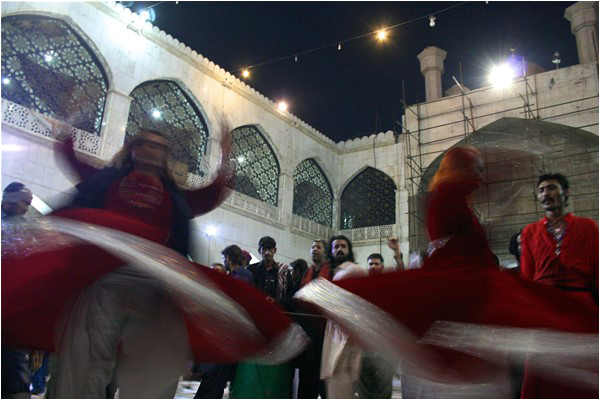
Decades later, I discovered that Ali was indeed paramount in Sehwan, and in instances, almost inseparable from Qalandar, as was Jhule-Lal, the ancient god of the river Indus. Conventional divides of Shia versus Sunni were harder to observe here as was futile telling apart Sufi practices from Hindu ones—not that sectarian difference didn’t matter in Sehwan or that it didn’t play out in the devotional politics of the town. It just meant that plural imaginations of Qalandar made it possible for unlikely alliances to take shape in ambiguously sacred ways.
“Kahin mawla, kahin aqa, kahin hai
Ram Qalandar!”
(In one place, Ali, in another Muhammad, yet elsewhere, Qalandar is Ram)
Sacred places are never easy to describe, much less, define. If anything, palimpsests like Sehwan escape categorisation. Even after eight years of association with the place, I still struggle to meaningfully situate Sehwan in the broader archipelago of Sufi sites in Pakistan. Part of this difficulty stems from the historical fact that Sehwan has always been a place of pilgrimage. Its seven hundred years of Sufi history stand on its ancient reputation as the abode of Shiva. Its river-lined geography enshrines an old deity that survives in the modern day chant Jhule-Lal, an original call to a god that rocked along the currents of the river. And if this wasn’t enough, the Qalandar of history, as scholars would tell us, is far sketchier than the Qalandar of legend. What is easily said is how he stands at the cusp of so many conceptions of the divine and the charismatic. He is known to belong to an original band of thirteenth-century qalandars or antinomian mystics characterised by their perpetual wandering, their rejection of religious and social norms and extreme forms of asceticism. His Isma‘ili, Sufi, and Shivaite genealogies make him a plural and dynamic figure of devotion. Such complexities of heritage and ambiguities of inheritance play out in the polysemic understandings of the place as well as its plural lifeworlds. No wonder, only in Sehwan does one see, in a single eyeshot, bodies of women in rapture with those of young men and transgender visitors; crossing paths are snake-charmers and sex-workers, Hindu devotees and Shia mourners, visiting fakirs and daily vendors, wow-making villagers as well as urban enthusiasts. It attracts the poorest of the poor but its devotees have also included the country’s former prime ministers, its top fashion models and photographers. Sehwan is indeed special. Yet it is not in the exceptionalism of such places but in its microcosmic mirrors that one finds a sense of perspective. In fact, the recent attack shows that Sehwan is not an isolated retreat but a place actively engaged with a Pakistan in transformation bearing the brunt of its broader political and social unrests.
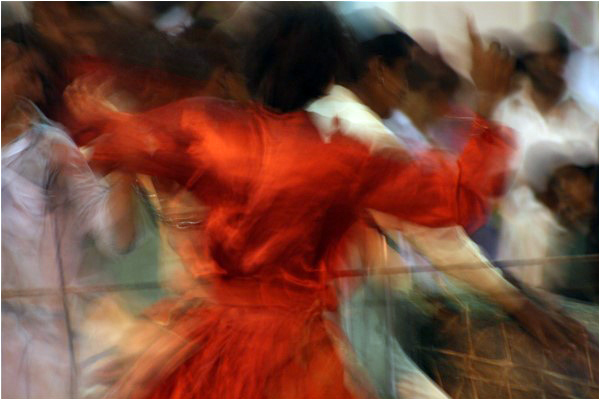
“This too is Pakistan” has become a shorthand for Sehwan when it comes to foreign reporting on the country. Journalists and cultural enthusiasts like to portray Sehwan as a haven for tolerant Islam, a site where intoxicated, merry-makers outnumber dangerously pious men and women. And strangely enough even Pakistan’s elite find comfort in such grotesque exercises of self-exoticising. On the one hand, by relegating the bizarre to the pastoral, the urban-liberal elite maintains a fantastic and magical world at an access-when-you-like distance from their everyday lives. On the other hand, by attributing authenticity to select manifestations of Islam, it rids itself of the responsibility to critique and therefore meaningfully engage with religion itself. Not just that, to portray an Islam of the shrines as simply tolerant, peace-loving and compassionate captures only the dynamism of what is easily observable at such places: shrine music, ritual dance, multi-faith pilgrims. All true. But historically deep-seated constellations of power, structures of orthodoxies, and contestations of authorities are much harder to observe. For example, the ‘soft’ paradigm removes from view Sufi alliances with institutions of the state and its historical allegiances with the powerful. It whitewashes its privileges, economies, and hierarchies that perpetuate inequalities across populations. It glosses over genealogical structures that systematically exclude women and social groups other than sayyids from positions of spiritual authority. It refuses to challenge patrilineal transmission of charisma. It overlooks the conflation of political and spiritual authority. It underplays the crucial intersections of the feudal with the mystical. Yet all of this does not take away from the fact that lifeworlds of the shrines are a lot more socially dynamic and inclusive than that of mosques in Pakistan. That women and transgender individuals find a share of participation is worth noting; that cross-faith devotion is made possible has to be acknowledged; that shrines provide a continuum for ancient divinities in new forms cannot go without comment. But the trouble with contrasting an Islam of the mosques with that of an Islam of the shrines is that unlike mosques, saints’ shrines are not simply places of worship. Shrines are economic hubs; they are repositories of immense social and spiritual power; they are revenue-generating sites for its custodians; they are places of employment, healing, material and symbolic exchange; and above all saints’ tombs are pivots to spiritual and geographic territories (wilayat) that saints (walis) command. Shrines can in this sense run parallel to the projects of the nation state explaining the latter’s motivation for governing saints’ places and its interest in what goes on at shrines. The nationalisation of shrines in the early 1960s with the establishment of the Auqaf Department shows how incredibly aware the Pakistani state is of the economic, political as well as symbolic stakes at work.
“Jeko chawando Jhule-Lal, unhan ja thinda bera par!”
(Whosoever calls out to Jhule-Lal, their boats will come ashore)
Sehwan is in Sindh, but its saint is not a Sindhi icon. Sehwan is not Bhit Shah and Qalandar’s verses in Persian are not the warp and weft of Sindhi society as Bhittai’s poetry is. What is it about this enigmatic falcon-saint that overrides regional differences and attracts people of all faiths and ethnicities is a question worth asking. State patronage is a big part of the puzzle, yes, yet it isn’t the full story. The curious appearances of the saint in Punjabi films of the late 1960s, the power of Noor-jahan’s voice in dhamal songs and the private devotion of the Bhuttos from the 1970s onwards have all put Sehwan on the national stage. Road and rail networks of the 1980s made the saint ever more accessible and the increasing violence against Pakistan’s Shia, especially in the 1990s has since contributed to the shrine’s status as a prominent site of Shi‘i identification and protest. The gradual shift from Hindu custodians to Shia ones, and the systematic removal of Shivaite relics from the shrine itself by the Awqaf administration are also part of its ambiguously administered post-partition life. But what makes the modern story of Sehwan infinitely intriguing is how despite the explicitly Sunni agenda of the Awqaf, the state inadvertently ends up promoting a historically Shivaite and increasingly Shia site of devotion.
It is not hard to imagine why plural conceptions of the social and compound ideas of the divine, which places like Sehwan come to embody are deeply upsetting for a national imaginary built on its severance with a polytheistic Hindu world. Sehwan is simply Pakistan at its complex best. But what this also means is that if saints’ places are a threat to Islamists, in their reputations as sacred ambiguity and as rich repositories of material and symbolic capital, shrines are differently unsettling for a whole range of actors, institutions, ideologies, and structures that routinely seek to control, manipulate and instrumentalise their place and meaning in society.
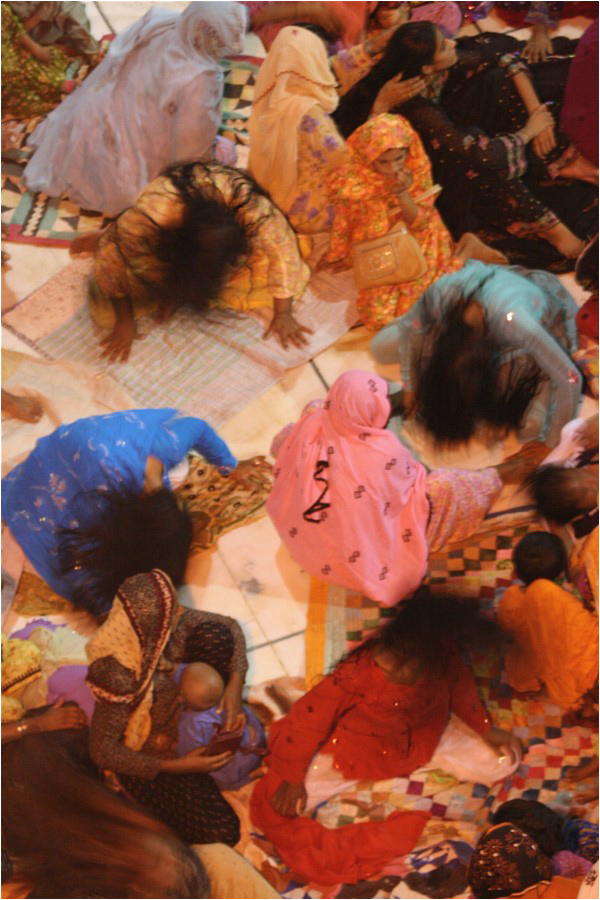
That evening in Sehwan, when the alleged suicide bomber entered the shrine’s premises, followers were performing the daily ritual of dhamal. Sehwanis can hardly agree on the origins of the ritual. Many associate dhamal with the dance of the mystics, now enshrined in visual iconography of the saint. Some locals have explained to me how the foot movements in dhamal memorialise the horrors of survivors’ walking through the desert in the aftermath of Karbala. And there are those who would describe it as living evidence of Sehwan’s Shivaite past. What is un-contestable however is the idea that dhamal is a daily ritual in Sehwan whose performance is only suspended during the 10 nights of Muharram. When Sehwanis returned to the shrine the very next day to perform the same ritual in the same courtyard where almost 90 people were killed, they chose continuity over disruption, resilience over fear. For in a place where the river and its currents stand for every metaphor of life, they know that its deity is invariably going to be on their side: Jhule L'al bere par.
The writer is a research associate at the Institute for Social and Cultural Anthropology at the Freie Universität Berlin

